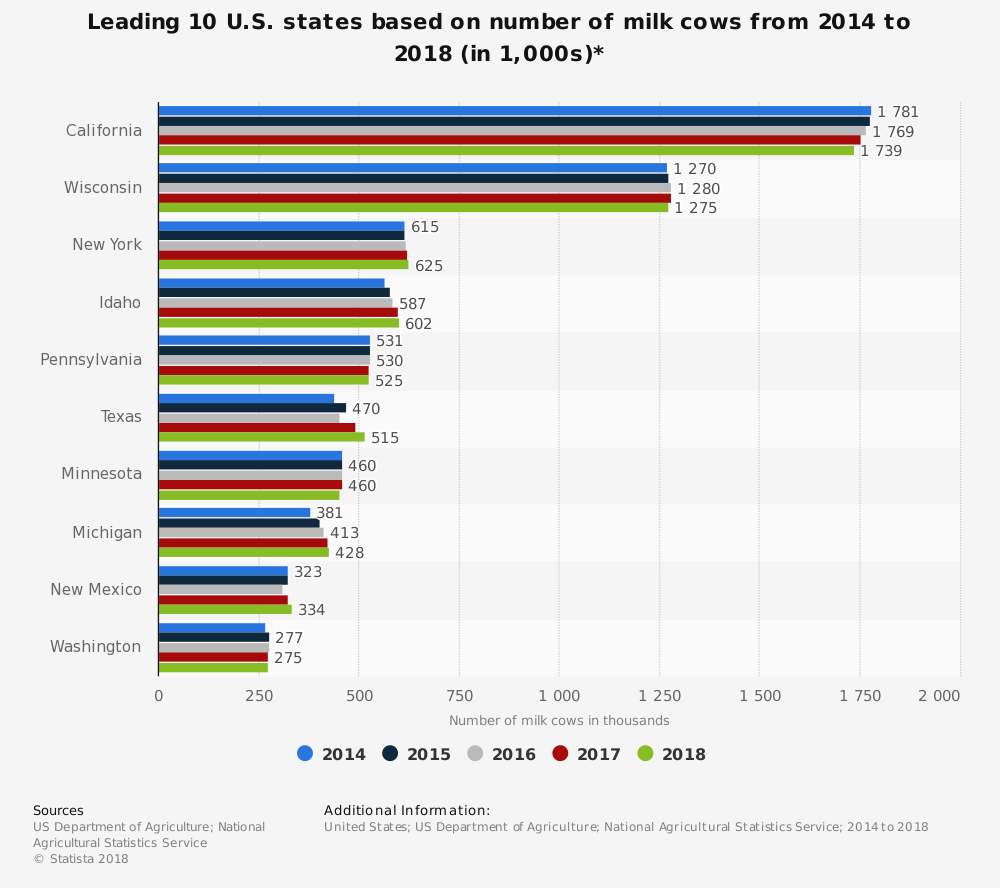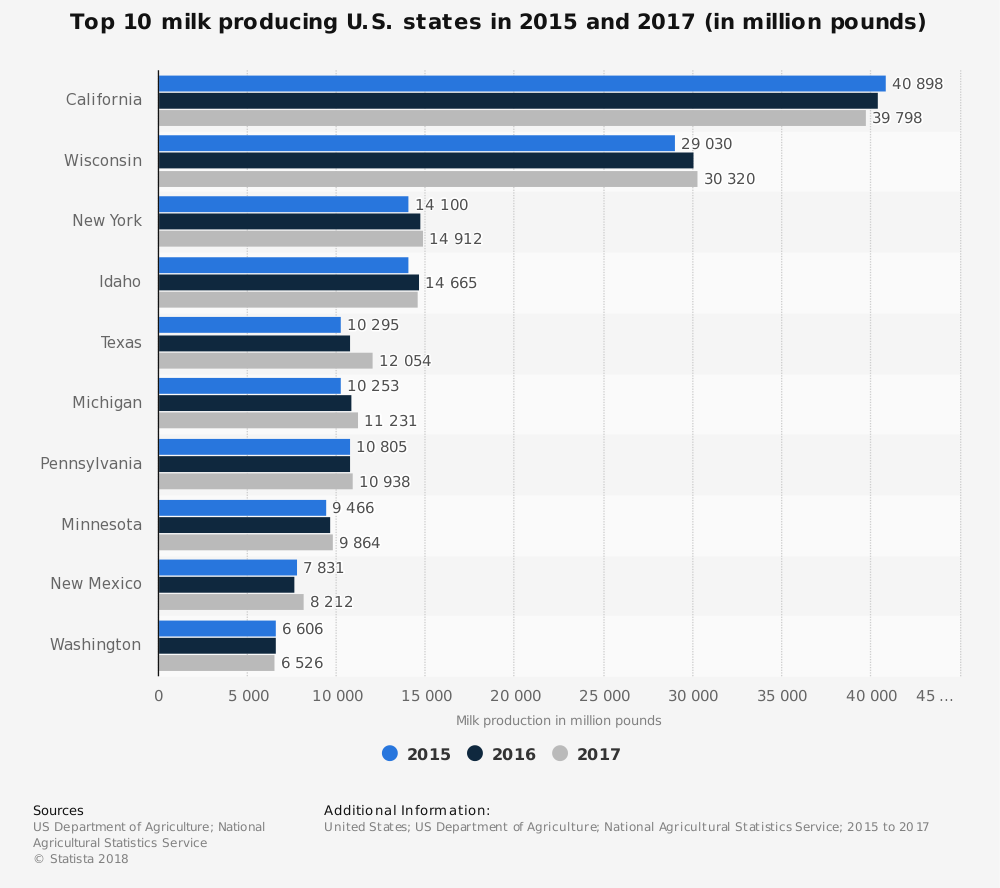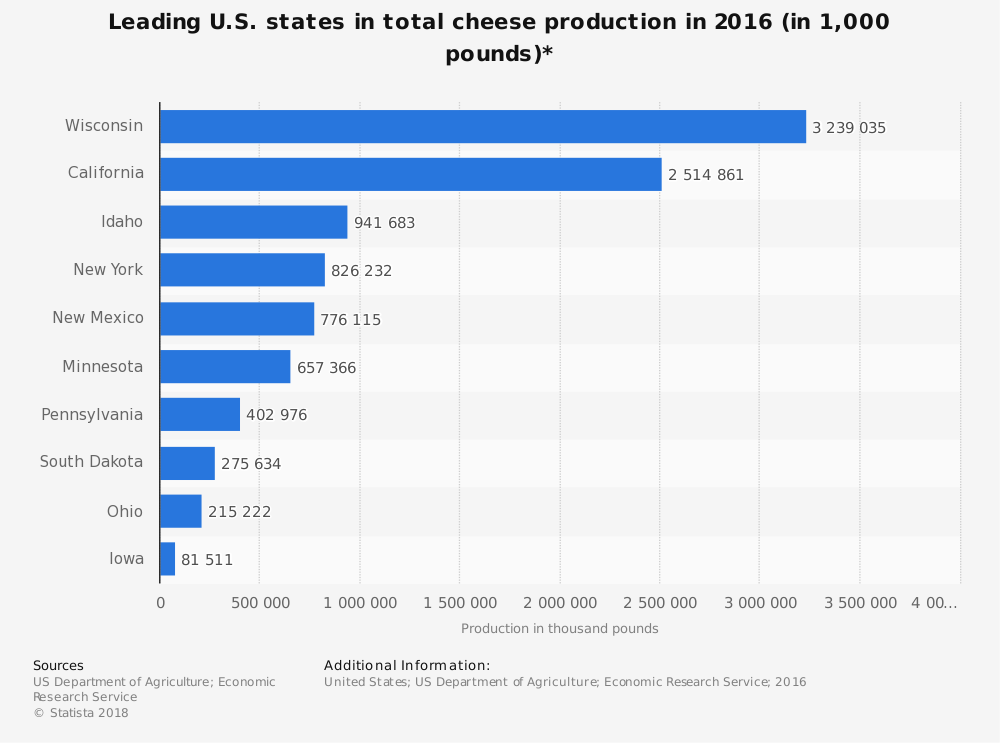Wisconsin has often been a national leader in dairy farming and dairy products. It wasn’t, however, the first agriculturally-based crop that farmers focused on in the state. Wheat was the initial crop, earning the state the nickname of “America’s Breadbasket.”
It became America’s “Dairy State” when the yields from wheat could not be sustained. Cheesemakers had come to Wisconsin during the wheat-growing days, though it wasn’t considered a viable career alternative until the wheat market in the state collapsed in the 1850s. By 1899, 90% of Wisconsin farms were involved in the local dairy industry.
With help from the University of Wisconsin and several associations, such as the Dairyman’s Association, dairy farming continued to grow. Immigrants from Germany, Scandinavia, and Switzerland encouraged dairy farming by introducing local cheeses to the economy. By 1915, Wisconsin was producing more cheese and butter than any other state.
Important Wisconsin Dairy Industry Statistics
#1. There are currently over 8,700 licensed herds operating in the state of Wisconsin as of March 2018 within the dairy industry. That means there are currently 1.275 million dairy cattle in Wisconsin right now. (Wisconsin Milk Marketing Board)
#2. The average number of dairy cattle that are owned by a farmer is 146, as of February 2018. (Wisconsin Milk Marketing Board)

#3. Wisconsin produces about 2.33 billion pounds of milk per month. That places the state in second place in terms of overall milk production, behind California. Wisconsin lost the title of the country’s leading dairy state in 1993, when California overtook the industry to be ranked first in butter, ice cream, milk, and nonfat dry milk. (California Dairy Press Room)
#4. Total monthly milk production per cow in Wisconsin is about 1,830 pounds. That equates to around 213 gallons of milk per cow. The average cow in Wisconsin can produce 65 pounds of milk per day, or just under 8 gallons of milk. (Wisconsin Milk Marketing Board)
#5. In 2017, Wisconsin dairy production rose by 0.7%. In comparison, California milk production declined by 1.7%. That gives the Wisconsin dairy industry a 14.1% share of overall milk production in the United States. (Wisconsin Milk Marketing Board)
#6. Average milk production per cow in Wisconsin is up by 0.8%, while it is down in California by nearly a full percentage point. (Wisconsin Milk Marketing Board)
#7. There are an estimated 40,000 dairy farms in the United States. About 9,000 of those farms are located in Wisconsin. Overall, dairy farming has become less popular, as farm numbers are down in the state by 4.5%. Nationwide, dairy farm numbers are down 3.8%. (Wisconsin Milk Marketing Board)
#8. 75% of the dairy farms that are located in Wisconsin own fewer than 100 cows. Most farms, over 50%, own between 50-99 head. There are just as many farms that own 19 or fewer head as there are farms that own between 200-499 head. Just 3.5% of dairy farms in Wisconsin own more than 500 cows. (Wisconsin Milk Marketing Board)
#9. In 2015, per capita consumption of dairy products in the United States reached its highest levels since 1964. In that year, each person consumed a total of 627 pounds of dairy products. U.S. consumption per capita has been over 600 pounds, per person, for more than a generation. (Wisconsin Milk Marketing Board)
#10. Although dairy product consumption is reaching record highs, actual fluid milk consumption is declining at a rapid pace. In 2015, just 155 pounds of per capita milk consumption occurred in the United States. That is 30 pounds less per person than in 2005. (Wisconsin Milk Marketing Board)

#11. Reduced fat or low-fat milk is the largest segment of the fluid milk market in the United States. The average household purchases 76.6 pounds of this fluid milk product per year. Plain whole milk is the next popular, at 45.4 pounds. Non-fat milk sales average 17.7 pounds per year, while flavored milk drinks average 13.9 pounds per year. (Wisconsin Milk Marketing Board)
#12. About 80% of the milk that comes from Wisconsin is directed toward cheese production. Nationwide, about 42% of fluid milk products go toward cheese production. (Wisconsin Milk Marketing Board)
#13. Every $1 generated by the Wisconsin dairy industry puts $1.79 back into the state’s economy in other places. (State of Wisconsin Department of Agriculture)
#14. There are more than 68,500 farms located in the State of Wisconsin, with 14.3 million acres dedicated to various farming needs. The average size of a farm in the state is 209 acres. (State of Wisconsin Department of Agriculture)
#15. Agricultural jobs in Wisconsin, which includes dairy farming, are responsible for nearly 12% of the state’s total employment. On-farm production offers direct employment opportunities for about 154,000 people every year. (State of Wisconsin Department of Agriculture)
#16. In total, the dairy industry in the State of Wisconsin contributes an average of $43 billion annually to the economy. That means $82,500 is generate every minute by the dairy industry. (State of Wisconsin Department of Agriculture)
#17. There are more than 1,200 licensed cheesemakers registered in Wisconsin. More than 600 types of cheese are authorized for production in the state, which is twice as many as California, which is the second-largest producer of cheese in the United States. (State of Wisconsin Department of Agriculture)
#18. More than 3.2 billion pounds of cheese was created in Wisconsin in 2016, including the only location in the country where limburger cheese is produced, in Monroe, WI. (State of Wisconsin Department of Agriculture)
#19. Wisconsin also leads the country in the production of aged cheddar, gruyere, gorgonzola, asiago, and gouda cheese. More than $3.5 billion in agricultural products is exported from the state every year. (State of Wisconsin Department of Agriculture)

Wisconsin Dairy Industry Trends and Forecast
Wisconsin is still America’s Dairyland, although the state has been out-produced in fluid milk products by California for over 20 years. The average herd size between the two states contributes to this fact. The average dairy farmer in California owns more than 1,000 additional cows when compared to the average Wisconsin dairy farmer.
Although the Wisconsin dairy industry is ranked second in several categories, cheese production continues to fuel the state. 25% of the cheese that is consumed in the United States comes from the state. Almost 150 countries receive agricultural products from the state.
Over the past decade, milk production in Wisconsin has increased by over 28%. Cheese production has increased by nearly 30%. If the state were its own country, it would be the fourth-largest cheese producer in the world. The farmers and associated professionals in the dairy industry have generations of experienced behind the work they are doing. This industry will continue to thrive.
Although millions of people visit Brandon's blog each month, his path to success was not easy. Go here to read his incredible story, "From Disabled and $500k in Debt to a Pro Blogger with 5 Million Monthly Visitors." If you want to send Brandon a quick message, then visit his contact page here. Brandon is currently the CEO of Aided.
